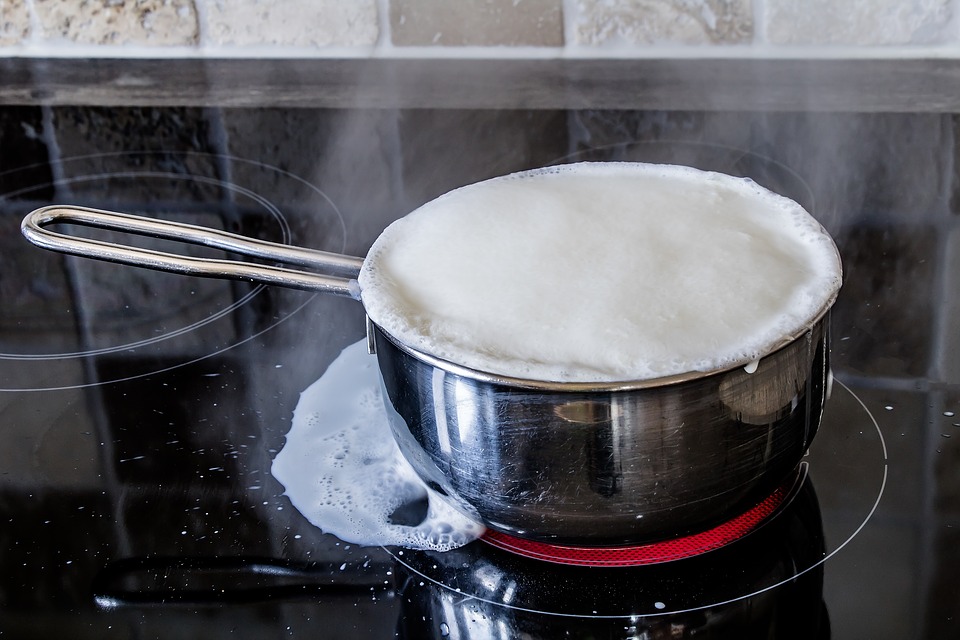The Hows and Whys of Scalding Milk- Plus A Delicious Scone Recipe!

Recently my sister and I were making breakfast for our families, and we had decided to make my mom’s delicious scones. Reading through the recipe, we saw that it called for scalded milk. We proceeded with the recipe, but both of us couldn’t help but wonder- what is the point of scalded milk? How does it differ from just adding milk?
Well first off, when a recipe calls for scalded milk, you’re basically going to bring the milk to just under a boil and then let it cool. Heat up the milk in a saucepan over medium heat, stirring frequently. Just before your milk is about to boil (so there’s little bubbles on the edges of your pan, a foamy substance at the top and the milk is steaming), take it off the heat and let it cool to your desired temperature. Be sure you don’t let it boil or you may have it spilling over like the picture above!
Pretty simple right? You’ll see this most often in recipes like fried scones or soft dinner rolls. But is it actually necessary?
Back in the old days, scalding milk was actually much more crucial than it is today. One of the biggest reasons for scalding milk was to kill bacteria that could be in the milk. Since most milk today is pasteurized, this isn’t really as necessary as it used to be (unless of course, you’re buying milk that is not pasteurized).
But that’s not the only reason for scalding milk. In addition to killing off any lurking bacteria, the added heat actually helps to break down the proteins in the milk, which can stop your yeast from rising. The scalding process kills off the whey protein and allows the gluten to do it’s thing, instead of being destroyed by milk proteins! Scalded milk also helps to dissolve sugar and yeast, which makes your breads/cakes lighter and fluffier- all good things when you’re shooting for the perfect springy dinner roll!
And while some may argue that since they buy pasteurized milk, they really don’t need to scald the milk, (because pasteurization literally means they are adding heat to the milk…. They’re basically already scalding it for you!), is that really something you want to risk when making delicious scones? Honestly, that’s completely up to you! Some people claim it makes no difference, and so you’re probably fine getting away without scalding. But keep in mind that warm milk will make your yeast rise faster, so that could be another reason to stick with tradition ;). In addition, warm milk (aka scalded milk) is fabulous for bringing out flavors like vanilla bean and cinnamon, so it’s definitely a safe route to go for getting lots of flavor!
If you’re using your scalded milk for something other than bread, like homemade yogurt or cheese, you’ll definitely still want to scald your milk. Since you’re not baking anything at high temperatures, it’s best to scald that milk to be extra sure there’s no nasty bacteria lurking in wait!
Scones
These are perfect for dessert or a decadent breakfast
Serving size: 14
Calories per serving: 288
3 cups scalded milk
1/2 cup shortening or margarine
1 tablespoon salt
1/2 cup lukewarm water
1/2 cup sugar
6 to 7 cups flour
2 tablespoons dry yeast
oil for frying
Directions:
*We like to top our scones with "frosting" made from powdered sugar, a little bit of milk, and extract. Vanilla and maple are our favorites!
These scones would be a fun Mother’s Day breakfast for sure- but whether you choose to make them or not, hopefully you can use what you’ve learned about scalded milk to make the perfect Mother’s Day rolls this year!
- https://pastrychefonline.com/how-to-scald-milk/
- https://www.savoryexperiments.com/how-to-scald-milk/
- https://www.allrecipes.com/video/140/how-to-scald-milk/
- https://pixabay.com/photos/boiling-over-of-milk-ceramic-hob-2474181/
 Camille Hoffmann
Camille Hoffmann
Monthly Newsletter Contributor since 2014
Email the author! camille@dvo.com
